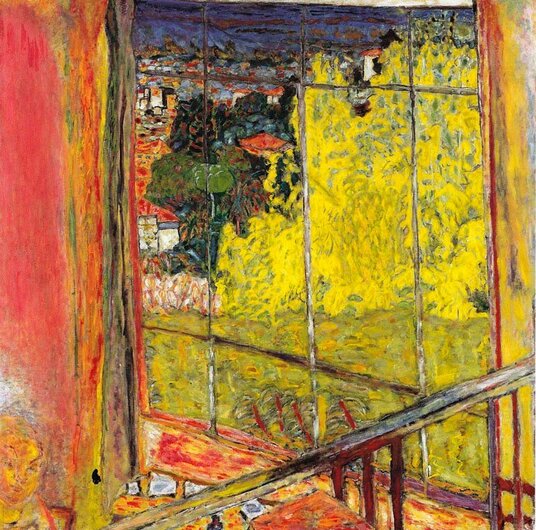|
Studio with Mimosa Their day together was off to a bad start. She tried to take his hand, but he shook it off, and walked a few paces ahead of her, the way she hated, fast and furious, seeing nothing around him, nothing of the vibrant, beautiful old city. But for Isabel it became suddenly bright again. At the Centre Pompidou there was among the others a Bonnard beyond telling—colours in absolutely perfect combination, a red worth having lived for. Yellow so intense it lit your soul. A conflagration of yellow, bordered by red. Studio with Mimosa, lost in reproduction. She sat and bathed in its radiance, marvelling. The others were good too, very good indeed, but this was perhaps the best of all, ever. A tall paned window with the fiery yellow mimosa outside—inside—it. Not a wrong note. As she sat lost in the colours, feeling them through and through, she was saddened to see people come into the room and leave again almost immediately with apparent indifference, not realizing what a transformative experience they might have had if they had only paused, looked closer. She felt sorry for them. She repeated the artist’s words to herself, under her breath. “And it’s because people have no idea how to look that they hardly ever understand.” The Pompidou was mostly modern art, and when she came to her senses again she discovered that Max had gone off without a word to prowl restlessly among the things which left Isabel cold—the revolutionary howl of primary colours, and sculptures that cut you visually with their sharp, ungiving edges. Bonnard’s work oddly straddled two periods, two completely different aesthetics, and she was learning that often as not you found him, like this, in a completely wrong context, cheek by jowl with the edgy moderns. He wasn’t an Impressionist, either, by definition, since he didn’t paint the fleeting impressions of the moment but from memory, as much as twenty years later, the landscapes and interiors of the past carefully considered and reworked, but he fit so much better there among the Impressionists, neighboured by Monet as he had been in life. # On one of the quays before they crossed to Notre Dame she spotted two Bonnard drawings for sale in a print shop window. And though the rest of the day was spent compromising so that neither of them got to do what they really wanted, Isabel carried the flame of the Pompidou’s Studio with Mimosa with her in her heart the whole while, like a Pentecostal blessing, and felt proof against the worst of her silent companion’s displeasure, within its yellow blaze. Christie B. Cochrell This is an excerpt from the author's novel about a mysterious painting by Pierre Bonnard. Though not yet published, it was shortlisted for the Eludia Award (Hidden River Arts). Christie B. Cochrell is an ardent lover of the play of light, the journeyings of time, things ephemeral and ancient. Her work has been published by Tin House and The Catamaran Literary Reader, among others. She has won the Dorothy Cappon Prize for the Essay and the Literal Latté Short Short Contest. Once a New Mexico Young Poet of the Year in Santa Fe, she now lives and writes by the ocean in Santa Cruz, California.
1 Comment
Charlotte Berney
5/11/2019 07:20:49 pm
I love Bonnard's art but have never thought about his place in the scheme of things. Thanks for helping me see and understand!
Reply
Your comment will be posted after it is approved.
Leave a Reply. |
The Ekphrastic Review
COOKIES/PRIVACY
This site uses cookies to deliver your best navigation experience this time and next. Continuing here means you consent to cookies. Thank you. Join us on Facebook:
July 2024
|




